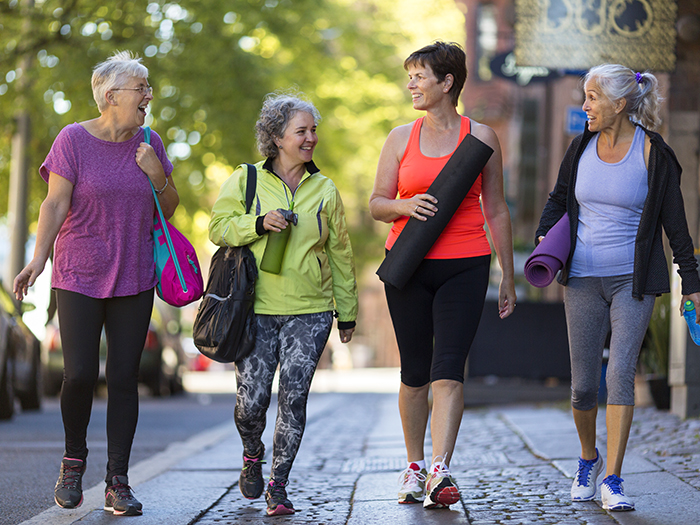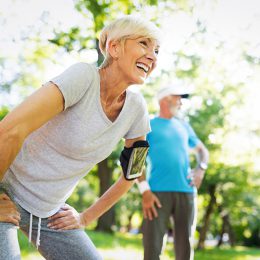6 Steps to Getting Healthy and Fit in Your 60s, 70s and Beyond
Even if you’ve been a couch potato for decades, now is the perfect time to get up, get moving and get fit. Here’s why—and how.

Looking for a fountain of youth? Just look for your sneakers. Then lace them up and get moving.
Exercise can turn back the clock, jumpstart your energy, and restore your health.
That’s the message we heard over and over when we asked the SilverSneakers Facebook community for a dose of fitness inspiration. Some said they didn’t start exercising until they were well into their 60s, but a desire to thrive in their retirement years sparked their interest.
Others fell out of the fitness habit during the hustle and bustle of raising families and building careers in midlife. Often, a health scare is what lit the fire to move more.
Whatever the reason, this group is clearly on to something. Physical activity is key to a happier, healthier life for older adults, according to 2020 research published in the International Journal of Environmental Research and Public Health.
Those findings are backed up by reports from the Centers for Disease Control and Prevention, which boasts that exercise is good for your heart, muscles, bones, brain and emotional well-being.
Staying physically active as you get older helps protect against some of the biggest health problems older adults face, including:
Daily physical activity has also been shown to help ward off dementia and Alzheimer’s disease, reports the CDC. In fact, one study showed that cognitive decline is almost twice as common among adults who aren’t active compared to those who are.
Get and stay active with SilverSneakers! Classes and events are happening right now at participating gyms, online through SilverSneakers LIVE, and at community centers near you. Activate your free online account to get started.
As for that fountain of youth? Getting at least 150 minutes of moderate-intensity physical activity a week has been linked to a 20% lower risk of early death from any cause, according to a 2022 report from the American Heart Association.
But even small amounts of activity — five to 10 minutes, if that’s what you can manage — can help your health. In other words, exercise won’t make you live forever, but it could help you live longer and better.
Here, SilverSneakers community members share the steps they’ve taken to prioritize their fitness, no matter how many birthdays they’ve celebrated.
Step #1: Start Small
Maybe you haven’t played sports since high school, or maybe you’ve never exercised before. That’s okay. Starting small is good, and just starting is even better.
Just ask Lori H., who started SilverSneakers classes after she retired at 68. Now in her mid-70s, she says, “I am in the best shape of my life. I can do over 12 pushups from the floor and hold the plank for 90 seconds. My clothes fit better, and I have the energy now to hike in North Carolina with my husband.”
Lori finds inspiration among her fellow exercisers. She points out, “There are ladies in my class who are in their late 80s and two who are 90.”
Step #2: Find a Workout Partner
Ideally, recruit someone around your own age. Seniors stick to their fitness routines best when they work out together, science says.
In fact, older adults who participated in a fitness program with others in their age group were three times more likely to come to exercise classes, according to researchers from the University of British Columbia.
That’s the kind of camaraderie that keeps Linda J. showing up for workouts.
“I started in my 60s after being diagnosed with diabetes,” she says. “I go to a senior center, and I love the group — I wouldn’t do it at home on my own!”
Step #3: Ignore Your Excuses
It may be great to have a friend to exercise with, but if you’re on your own, don’t be nervous. Take a deep breath and do it anyway.
“Don’t wait for your spouse or buddy to get started,” says Susan S., who started yoga at 60 and SilverSneakers classes at 67.
“If I had waited for those folks, I’d still be waiting — and 22 pounds heavier,” she says. “You have to be your own advocate and care about yourself and your well-being. You deserve to feel good!”
Plus, you never know — you could meet your new best friend. “I’ve met some wonderful, interesting, fun folks,” Susan says.
And those new friends come with health benefits. Social isolation is comparable to smoking 15 cigarettes per day, according to Brigham Young University researchers. Maintaining strong relationships can improve your health and quality of life.
Step #4: Embrace New Experiences
In her 60s, Bunny D. was an exercise newbie. “I’d never been active,” she says. “But I moved in to take care of my mom, and I need to be strong to care for her.”
Bunny started with a SilverSneakers water aerobics class and soon added walking. Things really took off from there.
She’s even walked-jogged two 5Ks, she says. In one race, she finished first in her age group. And in the other, second.
Your body isn’t the only thing that will benefit from new challenges. Learning and trying new things keeps the brain healthy and cuts your risk of dementia.
Subscribe to our newsletter
It's quick and easy. You could be one of the 13 million people who are eligible.
Already a member? Click to discover our 15,000+ participating locations.
Follow Us
Step #5: Make It a Habit
Robin H. was always active — bicycling, gardening, riding horses — but she never went to the gym. That changed after surviving cancer and recovering from a heart attack in her early 60s.
“I turned into a gym rat,” she says. At first, her workout schedule was tough. “But it became the backbone of my life. It gave my life order, purpose, and a challenge.”
Now in her 70s, Robin exercises three to four times a week. “What keeps me going is how good I feel physically and how much I enjoy the accomplishment. Exercise is a part of my life now, and I feel privileged every time I go to the gym.”
Step #6: Start Again If You Need To
If you grew up very active but put exercise on the back burner in your 30s or 40s because “life got in the way and work took too much time,” Susan B. understands completely.
“The next thing I knew, I was 59 and had a double mastectomy,” she recalls. “I was so depressed. I was using a cane, was very overweight, and wouldn’t look at myself in the mirror.”
But Susan’s story doesn’t end there. “I realized I was not going to live long the way I was going,” she says.
She joined a senior activity center. “I met so many people like me. We encourage each other and support each other,” she says.
By her late 60s, Susan was walking a couple of miles at a time without a cane. She also goes to a chair yoga class three days a week, and has learned to use fitness equipment at her gym. She’s even taking fewer pain medications.
More than that, she has a positive outlook on life. “I’m happier, and I know I have many more happy days to come.”
Her top tip? “Get up and tell yourself you are worth it — then go have fun!”
Take Your Favorite SilverSneakers Classes Online!
SilverSneakers members can access live fitness classes and wellness workshops through SilverSneakers LIVE. Activate your free online account to get started.
Not a member? If you have a Medicare Advantage Plan, it may include SilverSneakers—at no additional cost. Check your eligibility instantly here.
Not eligible for SilverSneakers? You can still get 200+ free SilverSneakers On-Demand videos and stay in touch with us by creating your online account.





